Adrian Collins's Blog, page 86
August 16, 2023
REVIEW: Dragons of Fate by Margaret Weis and Tracy Hickman
I am a lifelong fan of Dragonlance and a story heavily focused on the history of the setting as well as how a bunch of time-travelers may muck it up is squarely in my wheelhouse. So, I was very excited about Dragons of Fate after finishing the previous Dragons of Deceit. While I had some issues with the first book, mostly its excessive humor, I have to say this book compensates for it as well as makes use of two of my favorite characters: Sturm and Raistlin.
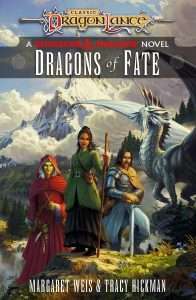 The premise is Sturm, Raistlin, Tasslehoff, and Destina have found themselves in Solamnia during the Era of Huma Dragonbane. They have the Graygem of Gargath and it is leaking Chaos into the world. It’s not a great situation and despite our heroes attempts not to change anything, things start adding up as their moralities as well as confusion over what to do with their circumstance keep making little alterations to the timeline.
The premise is Sturm, Raistlin, Tasslehoff, and Destina have found themselves in Solamnia during the Era of Huma Dragonbane. They have the Graygem of Gargath and it is leaking Chaos into the world. It’s not a great situation and despite our heroes attempts not to change anything, things start adding up as their moralities as well as confusion over what to do with their circumstance keep making little alterations to the timeline.
If you’re not familiar with Huma or the War of the Lance, this book probably won’t hit you as hard as it should. This is definitely a book for longtime fans of the series and the more you know about what a High Clerist’s Tower is or why the Blue Lady showing up on a certain day is a very bad thing, the more you will enjoy the book. Fans with a more passing familiarity will still enjoy the book, though, and the strength of the characters shines through.
I complained about Destina’s characterization last book as she seemed, bluntly, a bit on the thick side mentally. Here, she’s much improved by being more realistic about her actions as well as the potential consequences for her failure. I’m a bit saddened that she and Tasslehoff don’t continue their romance, though, since that was an unexpected twist I really enjoyed in the previous book. It may have been under false pretenses but I think she couldn’t do better than a Hero of the Lance. Tasslehoff has saved the world, after all. Three times!
The real star of the book is Raistlin Majere, though, and I have to say it’s fascinating to see him post-Legends. While stripped of about 90% of his magic, Raistlin is still a cunning adversary but he’s also learned a valuable lesson in humility. We also realize that Fistandantilus was influencing our hero the entire time that he was having his misadventures. This doesn’t make Raistlin innocent but it calls into question just what sort of person he might have been if not for that dark influence. It’s interesting to see Sturm and Raistlin start to develop a friendship under their strange new circumstances.
Supporting characters like Human Dragonbane, Magius, Gwyneth, and others all make the book quite entertaining. Seeing our protagonists play off what were only figures of legend to them is interesting. I also appreciated the fact we finally got to see the difference between Sturm and Huma. It turns out that, compared to Huma, Sturm is a bit of a wet blanket. Magius also indicates that Raistlin really may have just needed another wizard in the party.
This is only the second book in a trilogy and obviously ends in a cliffhanger. I will say that I am very excited about this series and am anxious to see how the setting will be changed by the final results. Definitely check this out if you’re a longtime Dragonlance fan. If you’re not, I think you’ll still enjoy it if you liked Dragons of Deceit (or even if you didn’t).
Read Dragons of Fate by Margaret Weis and Tracy HickmanThe post REVIEW: Dragons of Fate by Margaret Weis and Tracy Hickman appeared first on Grimdark Magazine.
August 15, 2023
An Interview With Richard Kadrey
Richard Kadrey is the New York Times bestselling author of twenty novels, including the acclaimed Sandman Slim series which debuted in 2009. Kadrey has also published over fifty short stories and several nonfiction books, including From Myst to Riven: The Creations and Inspirations. Kadrey also writes comics, movies, and articles on technology and culture for several newspapers and magazines. Outside of his prolific writing career, Kadrey is a photographer and cofounder of the avant-garde musical project, A Demon in Fun City.
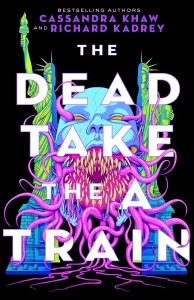 Kadrey’s latest novel, The Dead Take the A Train, is coauthored with Bram Stoker award-winning horror author, Cassandra Khaw. Issue #35 of Grimdark Magazine features interviews with both Kadrey and Khaw, as well as a review of their new novel. In our interview with Kadrey, we discuss the writing process and inspiration for The Dead Take the A Train, the Sandman Slim series, and Kadrey’s latest musical endeavors.
Kadrey’s latest novel, The Dead Take the A Train, is coauthored with Bram Stoker award-winning horror author, Cassandra Khaw. Issue #35 of Grimdark Magazine features interviews with both Kadrey and Khaw, as well as a review of their new novel. In our interview with Kadrey, we discuss the writing process and inspiration for The Dead Take the A Train, the Sandman Slim series, and Kadrey’s latest musical endeavors.
[GdM] Please tell us about your new collaboration with Cassandra Khaw, The Dead Take the A Train. What is it about?
[RK] It’s about Julie Crews, a supernatural operative who’s down on her luck and will do anything from demon hunting to exorcisms for quick cash. When her luck goes completely off the rails, she decides she finally needs to ask for help. So, she gets and old grimoire to summon a guardian angel—but things don’t turn out the way she wanted and soon, New York is awash in blood.
[GdM] What was the collaboration process like working with Cassandra? Did you split the chapters? Or was it completely collaborative from start to finish?
[RK] It was great. We alternated chapters at first, then went over each other’s work to smooth out the differences in our prose styles and, of course, to add new ideas. It was a messy, crazy way to work, but I think it came together in the end. Of course, we had a lot of help from our editors, Kelly Lonesome and Kristin Temple.
[GdM] The Dead Takes the A Train illuminates many corporate culture issues. How did this idea develop?
[RK] A lot of my previous books have been set in LA, which is a place of dreams and remaking yourself into a superstar. New York, to me, is the opposite of that. It’s a get to work, fuck you, get out of my way I have things to do town. And while LA is about dreams, New York is about money and power. That kind of energy draws dark magic to itself.
[GdM] Julie Crews is a total antihero. Her self-destruction and destruction of all those around her is a thing to behold. How did Julie come about?
[RK] Julie came from conversations early in the process. Julie always had a good heart, but can’t catch a break, so she self-medicates. I suppose, to be honest, that’s a bit of me from many years ago. But the Julie in the book has a better sense of humor about it. Plus, she’s stronger and smarter than I was, so she does something about her problems. And when things get really bad, she goes to her friends instead of just hiding out getting fucked up the way I did back then.
[GdM] What about the setting of The Dead Take the A Train drew you? It is as if the world rests on this base layer of filth and terror that normals don’t see.
[RK] I think people see the filth, the greed, and the terror. They just don’t know what to do about it, so they ignore it and hope it doesn’t get too up close and personal with them. Julie and her friends see it too but are more equipped to either fight the malevolent forces or find ways around them.
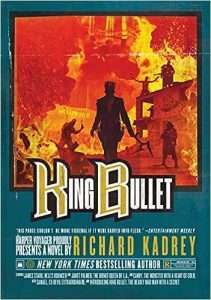 [GdM] If you put Sandman Slim in a room with Julie Crews, who would win the fight?
[GdM] If you put Sandman Slim in a room with Julie Crews, who would win the fight?
[RK] They would go to a bar, get drunk, and play old punk records on the jukebox until the bartender threw them out.
[GdM] What was it like writing the final Sandman book? Was it bittersweet?
[RK] Bittersweet is a good word for it. I wanted to give Stark a good ending, both for himself and the fans who’d stuck with him for so long. But, of course, I’m cheating too. Sandman Slim isn’t completely dead since I’m writing some stories set in that universe. Candy has a new solo story in my collection, The Secrets of Insects.
[GdM] Can you tell us about Seven Blood Stained Orchids? How did this solo project come about?
[RK] I was a musician for years, but was crippled by stage fright. One day, I couldn’t take it anymore, sold off all my gear, and ran away from music. Of course, I regretted it for a long time. Then, when we were in Covid lockdown a couple of years ago, I bought a little MIDI keyboard and Logic Pro software and started doing sound experiments. BC Smith—my partner in the band A Demon In Fun City—reached out to me on Facebook and gave me some good advice on how to get started back into music. I spent a year composing the pieces that became the Seven Blood-Stained Orchids album, The Devil in Amber. And while I was working on it, BC and I started collaborating on music, which was the birth of A Demon In Fun City. Our first album will be out in late June.
[GdM] Your new album is called The Devil in Amber. What is the title based on?
[RK] The title comes from an image in Guillermo del Toro’s movie, The Devil’s Backbone. In it, there’s a fetus stored in a jar of golden fluid. That image haunted me and I imagined the Devil caught in a similar jar, imprisoned forever in amber liquid.
[GdM] You wrote a novel in 1997, From Myst to Riven: The Creations and Inspirations. Myst is one of the first successful non-linear stories and implies nearly all of the story; very little is spelled out. The only reason to do that and why Myst could do that is because the worldbuilding is rock solid. What do you believe makes Myst so quintessentially “Myst-like?” Can a book author capture the same feeling as a game author? Or are they too different a media?
[RK] I think that books and games are very different animals. Each has its place in the world and they can influence each other, but I enjoy the fact that they’re different. I don’t want books to become more game-like, although if someone showed me an interesting way to it I’d be interested in trying.
[GdM] You have written and performed in many different formats. Do you approach all story creations the same? If not, how do you approach each different type of creative project?
[RK] All my stories begin the same way: I scrawl on yellow legal pads or start typing in a blank Word doc. At first, it’s like automatic writing. Just putting down words and images with no connection or purpose. If I do that long enough, I often find that patterns emerge and a story slowly begins to present itself. Of course, a lot of those experiments generate nothing but garbage, but I still like the messy process.
[GdM] Finally, if you were to pick favorites, which books would you choose for your favorite prose, worldbuilding, action, overall favorite, and why?
[RK] Cormac McCarthy’s Blood Meridian is probably my favorite book. It’s like an Elmore Leonard western but told by an angry Old Testament God.
I’m interested in the idea of gods and belief system and for that reason, I enjoyed Neil Gaiman’s American Gods.
I love Robert Stone’s Dog Soldiers both for its prose and its examination of an exhausted American culture during the Vietnam War.
Recently, I enjoyed CJ Leede’s wild debut novel, Maeve Fly. It’s a warped and bloody love letter to a fucked up LA as written by a serial killer who’s embraced all the city’s absurdities and excess.
Read The Dead Take the A TrainThis interview by John Mauro and Beth Tabler was originally published in Grimdark Magazine Issue #35.
The post An Interview With Richard Kadrey appeared first on Grimdark Magazine.
August 14, 2023
Ten cinematic sci-fi and fantasy novels for grimdark fans
As avid readers, we know it’s always a great time to pick up a good book. With Hollywood on strike, now is an especially opportune time to discover great new reads, especially those with a cinematic style that brings the story vividly to life. Here are ten novels for dark sci-fi/fantasy fans which prove that curling up with a good book can be just as breathtaking as watching the latest Hollywood blockbuster.
Jade City by Fonda LeeFor Fans of The Godfather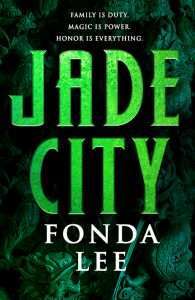 Jade City is Fonda Lee’s World Fantasy Award-winning urban fantasy set in the Asian-inspired island nation of Kekon. Jade City is the nickname for Janloon, the capital of Kekon, which is controlled by mafia-style gangs led by organized crime families.
Jade City is Fonda Lee’s World Fantasy Award-winning urban fantasy set in the Asian-inspired island nation of Kekon. Jade City is the nickname for Janloon, the capital of Kekon, which is controlled by mafia-style gangs led by organized crime families.
Jade City has a cinematic quality that reminds me of watching The Godfather or Goodfellas. Fonda Lee’s writing is so captivating that, as a reader, I felt like an extra on the set of a movie, watching the action up-close. As a black belt martial artist, the detail that Fonda Lee brings to fight sequences makes them especially realistic, reminding me of the best fight scenes from Hong Kong and Taiwanese martial arts films. The emotional intensity of these action sequences is matched by several heartbreaking scenes throughout the novel.
Jade City is a breathtakingly original, pulse-pounding urban fantasy and a triumph in every sense.
Read the full review here.
ABOUT THE BOOKJade City is a gripping Godfather-esque saga of intergenerational blood feuds, vicious politics, magic, and kung fu.
The Kaul family is one of two crime syndicates that control the island of Kekon. It’s the only place in the world that produces rare magical jade, which grants those with the right training and heritage superhuman abilities.
The Green Bone clans of honorable jade-wearing warriors once protected the island from foreign invasion—but nowadays, in a bustling post-war metropolis full of fast cars and foreign money, Green Bone families like the Kauls are primarily involved in commerce, construction, and the everyday upkeep of the districts under their protection.
When the simmering tension between the Kauls and their greatest rivals erupts into open violence in the streets, the outcome of this clan war will determine the fate of all Green Bones and the future of Kekon itself.
Read Jade City by Fonda LeeThe Shadow Glass by Josh WinningFor Fans of Labyrinth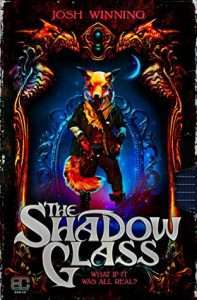 If you ever danced with the Goblin King, cried when Artax died, or were a little bit scared of Skeksis when you were young, then The Shadow Glass will have you pumping your fist and grinning like an idiot.
If you ever danced with the Goblin King, cried when Artax died, or were a little bit scared of Skeksis when you were young, then The Shadow Glass will have you pumping your fist and grinning like an idiot.
Jack is the son of Bob Corman, an eccentric who made a cult classic fantasy movie called The Shadow Glass. As an adult, Jack is estranged from his father. He hates Bob’s movie, as it represents everything that is wrong in his relationship with his dad. When Bob dies, Jack decides to sell the memorabilia from the cult classic film. But plans crash down abruptly as he learns that the fantasy puppets are no longer only puppets. Somehow, they’ve become flesh and blood heroes and villains in a war that has spilled from fantasy into reality.
From the characters to the storyline, every word is perfectly placed. The Shadow Glass is a delightful smorgasbord of nostalgia and fun, while at the same time exploring themes of loss, love, grief, and self-discovery.
Read the full review here.
ABOUT THE BOOKJack Corman is failing at life.
Jobless, jaded and on the “wrong” side of thirty, he’s facing the threat of eviction from his London flat while reeling from the sudden death of his father, one-time film director Bob Corman. Back in the eighties, Bob poured his heart and soul into the creation of his 1986 puppet fantasy The Shadow Glass, a film Jack loved as a child, idolizing its foxlike hero, Dune.
But The Shadow Glass flopped on release, deemed too scary for kids and too weird for adults, and Bob became a laughingstock, losing himself to booze and self-pity. Now, the film represents everything Jack hated about his father, and he lives with the fear that he’ll end up a failure just like him.
In the wake of Bob’s death, Jack returns to his decaying home, a place creaking with movie memorabilia and painful memories. Then, during a freak thunderstorm, the puppets in the attic start talking. Tipped into a desperate real-world quest to save London from the more nefarious of his father’s creations, Jack teams up with excitable fanboy Toby and spiky studio executive Amelia to navigate the labyrinth of his father’s legacy while conjuring the hero within––and igniting a Shadow Glass resurgence that could, finally, do his father proud.
Read The Shadow Glass by Josh WinningA Gamble of Gods by Mitriel FaywoodFor Fans of Indiana Jones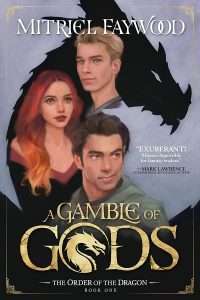 A Gamble of Gods is the highly imaginative, world-hopping debut by Mitriel Faywood. Faywood’s debut is a genre-defying story, impossible to categorize using conventional literary classifications. The experience of reading A Gamble of Gods is more like watching a blockbuster movie: a hugely entertaining, immersive experience, where the heart-pounding action is balanced by a cheerful levity and even some romance.
A Gamble of Gods is the highly imaginative, world-hopping debut by Mitriel Faywood. Faywood’s debut is a genre-defying story, impossible to categorize using conventional literary classifications. The experience of reading A Gamble of Gods is more like watching a blockbuster movie: a hugely entertaining, immersive experience, where the heart-pounding action is balanced by a cheerful levity and even some romance.
Faywood keeps up the fast-paced Indiana Jones-style action throughout A Gamble of Gods without ever having a dull moment. There is truly something here for everyone, and I particularly enjoyed the lighthearted comedy throughout much of the book. I laughed so hard during one scene at around the 75% mark that it almost caused me bodily injury.
So, grab yourself a big vat of popcorn to munch on as you enjoy this blockbuster debut. A Gamble of Gods is a rollicking good time.
Read the full review here.
ABOUT THE BOOKLife used to be good. I had money. I had fame. I had respect. The same thrill during work every day. A different woman in my bed every night. Best fighter to hire for dangerous jobs. Most famous thief in the Nineteen Kingdoms. Half the world sought my services when they needed the impossible done. The other half wanted to sleep with me.
Then one day this strange guy showed up with his even stranger pet, the latter a bit of a gift horse by all accounts, and turned it all upside down. They claimed to have come to save my life, and while they were at it, I got them to help out with the most important quest of my existence: finding the Supreme Key of the Dragon. Needless to say, none of it turned out quite how I expected. But we had fun, even if it was hell sometimes. In the end, what we found was worth it all.
My name is Conor Drew, the Gods destined me for great things.
But I turned them down.
Read A Gamble of Gods by Mitriel FaywoodThe Court of Broken Knives by Anna Smith SparkFor Fans of Apocalypse Now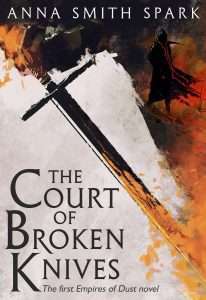
The Court of Broken Knives by Anna Smith Spark
The Court of Broken Knives established Anna Smith Spark as the Queen of Grimdark, and for good reason. This is grimdark fantasy of the highest caliber, with four complex lead characters in a bleak and violent world that feels like a medieval version of Apocalypse Now.
Anna Smith Spark’s sparse yet cinematic writing style is the perfect vehicle for delivering this brutal tale, with many poetic moments throughout the novel. The Court of Broken Knives is simultaneously ruthless and beautiful: truly a must-read for grimdark fans.
Read the full review here.
ABOUT THE BOOKThe Court of Broken Knives is the explosive debut by one of grimdark fantasy’s most exciting new voices.
They’ve finally looked at the graveyard of our Empire with open eyes. They’re fools and madmen and like the art of war. And their children go hungry while we piss gold and jewels into the dust.
In the richest empire the world has ever known, the city of Sorlost has always stood, eternal and unconquered. But in a city of dreams governed by an imposturous Emperor, decadence has become the true ruler, and has blinded its inhabitants to their vulnerability. The empire is on the verge of invasion – and only one man can see it.
Haunted by dreams of the empire’s demise, Orhan Emmereth has decided to act. On his orders, a company of soldiers cross the desert to reach the city. Once they enter the Palace, they have one mission: kill the Emperor, then all those who remain. Only from ashes can a new empire be built.
The company is a group of good, ordinary soldiers, for whom this is a mission like any other. But the strange boy Marith who walks among them is no ordinary soldier. Marching on Sorlost, Marith thinks he is running away from the past which haunts him. But in the Golden City, his destiny awaits him – beautiful, bloody, and more terrible than anyone could have foreseen.
Read The Court of Broken Knives by Anna Smith SparkThe Builders by Daniel PolanskyFor Fans of The Magnificent Seven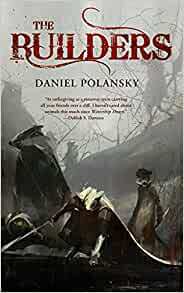 The Builders is Daniel Polansky’s riotous grimdark fantasy western featuring a band of gunslinging anthropomorphized animals bent on revenge.
The Builders is Daniel Polansky’s riotous grimdark fantasy western featuring a band of gunslinging anthropomorphized animals bent on revenge.
The Builders follows a grizzled mouse soldier known as the Captain as he assembles a ragtag team of adventurers in his pursuit of vengeance. Besides the mousey Captain, The Magnificent Seven-style team consists of a stoat, an opossum, a badger, a salamander, a mole, and an owl.
The Builders is a fast-paced thrill ride of action as the motley crew face their odious, odorous skunk enemy. The story is instantly absorbing, a testament to Daniel Polansky’s outstanding writing, which is full of dark wit, with plenty of laugh-out-loud moments. Personally, I found The Builders to be unputdownable, devouring the entire book in one afternoon.
Read the full review here.
ABOUT THE BOOKA missing eye. A broken wing. A stolen country.
The last job didn’t end well.
Years go by, and scars fade, but memories only fester. For the animals of the Captain’s company, survival has meant keeping a low profile, building a new life, and trying to forget the war they lost. But now the Captain’s whiskers are twitching at the idea of evening the score.
Read The Builders by Daniel PolanskyThe Adventures of Amina al-Sirafi by Shannon ChakrabortyFor Fans of Pirates of the Caribbean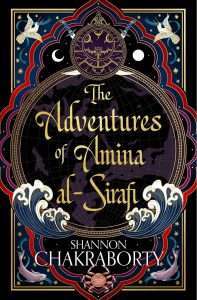
Cover for The Adventures of Amina al-Sirafi by Shannon Chakraborty
Some books are so magical you know within a few pages that they will end up on your favorites shelf. The Adventures of Amina al-Sirafi by Shannon Chakraborty is such a book, telling the magical tale of Amina, a medieval pirate in the Pacific, within the historical context of the Crusades. This book is compelling, twisty, and brilliant.
We spend most of the story with Amina and her motley crew of sailors, reassembled by necessity. Shannon Chakraborty weaves in mythology, history, and brilliant characters with an adventure story to create a plot that is also, most of all, fun to read.
The Adventures of Amina al-Sirafi is a masterpiece and a must-read for those who enjoy historical fantasy, brilliant characters, and great storytelling. Oh, and there’s pirates and a good dose of fun and betrayal.
Read the full review here.
ABOUT THE BOOKShannon Chakraborty, the bestselling author of The City of Brass, spins a new trilogy of magic and mayhem on the high seas in this tale of pirates and sorcerers, forbidden artifacts and ancient mysteries, in one woman’s determined quest to seize a final chance at glory—and write her own legend.
Amina al-Sirafi should be content. After a storied and scandalous career as one of the Indian Ocean’s most notorious pirates, she’s survived backstabbing rogues, vengeful merchant princes, several husbands, and one actual demon to retire peacefully with her family to a life of piety, motherhood, and absolutely nothing that hints of the supernatural.
But when she’s tracked down by the obscenely wealthy mother of a former crewman, she’s offered a job no bandit could refuse: retrieve her comrade’s kidnapped daughter for a kingly sum. The chance to have one last adventure with her crew, do right by an old friend, and win a fortune that will secure her family’s future forever? It seems like such an obvious choice that it must be God’s will.
Yet the deeper Amina dives, the more it becomes alarmingly clear there’s more to this job, and the girl’s disappearance, than she was led to believe. For there’s always risk in wanting to become a legend, to seize one last chance at glory, to savor just a bit more power…and the price might be your very soul.
Read The Adventures of Amina al-Sirafi by Shannon ChakrabortyWistful Ascending by JCM BerneFor Fans of Guardians of the Galaxy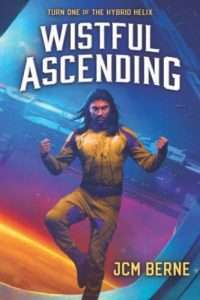 Wistful Ascending is JCM Berne’s debut superhero space opera and the first installment in his Hybrid Helix trilogy. Rohan is a hybrid, with a human mother and an alien father from the imperialist il’Drach race. He inherited superpowers from the paternal side of his family, including super strength and the ability to fly. After spending a decade fighting an intergalactic war, Rohan now wishes to live a quiet, anonymous life as a Tow Chief Second Class on the space station Wistful.
Wistful Ascending is JCM Berne’s debut superhero space opera and the first installment in his Hybrid Helix trilogy. Rohan is a hybrid, with a human mother and an alien father from the imperialist il’Drach race. He inherited superpowers from the paternal side of his family, including super strength and the ability to fly. After spending a decade fighting an intergalactic war, Rohan now wishes to live a quiet, anonymous life as a Tow Chief Second Class on the space station Wistful.
Wistful Ascending is full of space action. Despite Rohan’s superpowers, JCM Berne conveys a real sense of vulnerability for our hero. I found myself holding my breath while reading several of the action scenes. Through his compelling storyline and realistic character development, JCM Berne convinced this cynical grimdark reviewer that superheroes can be cool.
Read the full review here.
ABOUT THE BOOKA superhero space opera for grownups. For fans of Invincible and Marvel Cinematic Universe films who like a little hard science fiction in their superheroes.
The il’Drach have conquered half a galaxy behind the civilization-ending Powers of their mixed-species children. Half-human Rohan, exhausted by a decade fighting for their Empire, has paid a secret and terrible price for his freedom.
Now retired, he strives to live a quiet life towing starships for the space station Wistful. His most pressing problems are finding the perfect cup of coffee and talking to a gorgeous shuttle tech without tripping over his own tongue.
A nearby, long-dormant wormhole is opened by a ship full of scared, angry refugees, and the many eyes of the Empire focus uncomfortably on Wistful.
As scientists, spies, and assassins converge, reverting to the monster the Empire created is the surest way to protect his friends. And the surest way to lose them.
Read Wistful Ascending by JCM BerneOne Word Kill by Mark LawrenceFor Fans of Stranger Things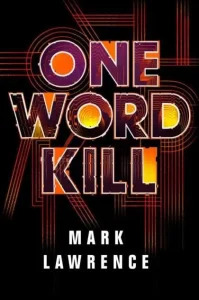 One Word Kill is Mark Lawrence’s science fiction-infused bildungsroman that takes place in London in 1986. The narrator, Nick, is a 15-year-old boy who has just been diagnosed with leukemia. He has, at best, a 50% chance of surviving until his twentieth birthday.
One Word Kill is Mark Lawrence’s science fiction-infused bildungsroman that takes place in London in 1986. The narrator, Nick, is a 15-year-old boy who has just been diagnosed with leukemia. He has, at best, a 50% chance of surviving until his twentieth birthday.
Nick is a mathematical prodigy and a social outcast with a small circle of close friends who love playing Dungeons & Dragons and discussing the metaphysical implications of quantum mechanics. The sci-fi elements come when Nick is approached by a visitor from the future with an important message that could rescue him from cancer, but more urgently for Nick, save his troubled new friend, Mia.
One Word Kill is full of 1980s nostalgia, with plenty of references to classic board games, television shows, movies, and music of the era. As with Mark Lawrence’s fantasy novels, One World Kill is hyperintelligent and beautifully written.
Read the full review here.
ABOUT THE BOOKIn January 1986, fifteen-year-old boy-genius Nick Hayes discovers he’s dying. And it isn’t even the strangest thing to happen to him that week.
Nick and his Dungeons & Dragons-playing friends are used to living in their imaginations. But when a new girl, Mia, joins the group and reality becomes weirder than the fantasy world they visit in their weekly games, none of them are prepared for what comes next. A strange—yet curiously familiar—man is following Nick, with abilities that just shouldn’t exist. And this man bears a cryptic message: Mia’s in grave danger, though she doesn’t know it yet. She needs Nick’s help—now.
He finds himself in a race against time to unravel an impossible mystery and save the girl. And all that stands in his way is a probably terminal disease, a knife-wielding maniac and the laws of physics.
Read One Word Kill by Mark LawrenceThe Combat Codes by Alexander DarwinFor Fans of The Karate Kid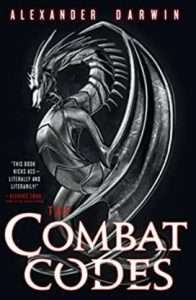 The Combat Codes is the debut martial arts science fiction by Alexander Darwin in which war has been replaced by hand-to-hand combat. Alexander Darwin is an accomplished martial arts master and also a wizard at writing well-choreographed, cinematic fight scenes. In this way, The Combat Codes feels much like a sci-fi version of The Karate Kid.
The Combat Codes is the debut martial arts science fiction by Alexander Darwin in which war has been replaced by hand-to-hand combat. Alexander Darwin is an accomplished martial arts master and also a wizard at writing well-choreographed, cinematic fight scenes. In this way, The Combat Codes feels much like a sci-fi version of The Karate Kid.
The Combat Codes is manna from heaven for martial arts enthusiasts, who will enjoy the breathtakingly realistic action scenes and philosophical discussions on the importance of martial arts.
Read the full review here.
ABOUT THE BOOKIn a world long ago ravaged by war, the nations have sworn an armistice never to use weapons of mass destruction again. Instead, highly skilled warriors known as Grievar Knights represent their nations’ interests in brutal hand-to-hand combat.
Murray Pearson was once a famed Knight until he suffered a loss that crippled his homeland — but now he’s on the hunt to discover the next champion.
In underground and ruthless combat rings, an orphaned boy called Cego is making a name for himself. Murray believes Cego has what it takes to thrive in the world’s most prestigious combat academy – but first, Cego must prove himself in the vicious arenas of the underworld. And survival isn’t guaranteed.
Read The Combat Codes by Alexander DarwinThe Scourge Between Stars by Ness BrownFor Fans of Alien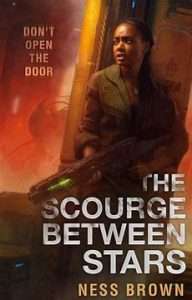 The Scourge Between Stars is the debut sci-fi horror by Ness Brown, an astrophysics graduate student and former astronomy instructor. Earth has become uninhabitable due to the unmitigated environmental damage of modern human civilization, and repairing the damage to Earth has been deemed too difficult compared to establishing civilization elsewhere. However, an attempt to colonize a faraway planet has also proved unsuccessful. Now the starship Calypso is headed back to Earth in a final effort to save the last of humanity.
The Scourge Between Stars is the debut sci-fi horror by Ness Brown, an astrophysics graduate student and former astronomy instructor. Earth has become uninhabitable due to the unmitigated environmental damage of modern human civilization, and repairing the damage to Earth has been deemed too difficult compared to establishing civilization elsewhere. However, an attempt to colonize a faraway planet has also proved unsuccessful. Now the starship Calypso is headed back to Earth in a final effort to save the last of humanity.
Jacklyn Albright is the acting captain of Calypso, filling the role vacated by her incapacitated father, who remains locked in his quarters, unresponsive to the needs of the crew. Jacklyn is left to face an increasingly dire situation with insufficient food and a growing threat of mutiny. But a new and harrowing threat arises when crew members are found murdered in gruesome fashion, purportedly by a hostile alien on board the ship.
The Scourge Between Stars is compulsively readable, with fast-paced plot kept me flipping through the pages of this short novel.
Read the full review here.
ABOUT THE BOOKAs acting captain of the starship Calypso, Jacklyn Albright is responsible for keeping the last of humanity alive as they limp back to Earth from their forebears’ failed colony on Proxima b.
Faced with constant threats of starvation and destruction in the treacherous minefield of interstellar space, Jacklyn’s crew has reached their breaking point. As unrest begins to spread throughout the ship’s Wards, a new threat emerges, picking off crew members in grim, bloody fashion.
Jacklyn and her team must hunt down the ship’s unknown intruder if they have any hope of making it back to their solar system alive.
Read The Scourge Between Stars by Ness BrownThe post Ten cinematic sci-fi and fantasy novels for grimdark fans appeared first on Grimdark Magazine.
August 13, 2023
REVIEW: Space Punks by Anna Mocikat
Space Punks by Anna Mocikat is a book I’ve been looking forward to for some time. It is a cyberpunk-space opera hybrid that is a bit akin Cowboy Bebop or Outlaw Star if you remember your Nineties anime. You could even compare it to Firefly, except the crew isn’t a bunch of Western Outlaws in Space but, well, multicolored hair cool punks who wouldn’t be out of place at a Ramones concert. You know, except for all the cybernetics.
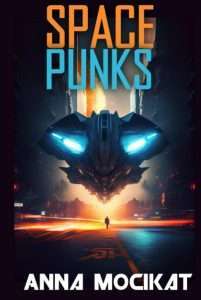 The premise is that in the distant future, humanity has barely survived a devastating war with the Machines and Earth has been destroyed. Which absolutely sucks since humanity has only barely colonized the Sol system and a handful of places outside of it. This, of course, has led to a thriving mercenary economy as people like the crew of the Nephilim (named after the protagonist of Behind Blue Eyes) struggle to make ends meat while living their indulgent free love lifestyle. With guns, lots of guns.
The premise is that in the distant future, humanity has barely survived a devastating war with the Machines and Earth has been destroyed. Which absolutely sucks since humanity has only barely colonized the Sol system and a handful of places outside of it. This, of course, has led to a thriving mercenary economy as people like the crew of the Nephilim (named after the protagonist of Behind Blue Eyes) struggle to make ends meat while living their indulgent free love lifestyle. With guns, lots of guns.
I like Anna Mocikat’s signature style of depicting the future as decadent, seedy, but very believable places. This similarly reflects her Behind Blue Eyes series that could have been the past of this world but is apparently just a fictional book series in this one. She has a way of making dystopias look sexy and cool while also not shying away from how horrible they are for 95% of the people in the world. Mostly because that number of people were killed in the past century by the Mats (robots).
We open this book with the perspective of David, who is locked into a gritty hellhole prison on Deimos where men as well as women are locked away together with no attempt to keep the prisoners in line. There’s nothing graphic but readers should be warned that the book opens up with an attempted sexual assault just to show how cyborg merc, Aztec, is able to rip apart some would-be rapists. This, of course, makes David immediately fall in love with Aztec and he’s soon roped into her scheme for a prison break.
One element I really enjoyed about this book is the fact that it is very much in the style of “micro-writing.” A lot of the book is very short scenes from the perspective one character of the Nephilim’s crew then switching to another’s perspective, sometime in the same scene. This is sometimes disorienting but, overall, was something I hadn’t experienced much of as a reader and rapidly gave me a strong sense of connection to the crew.
And while this may come out wrong, I liked the book’s handling of sex. Which is to say it handled in an unsentimental and matter-of-fact way. There’s a variety of relationships both casual and otherwise onboard the ship with no attempt to sanitize or play up the unconventional natures of them. David likes Aztec and she’s in an open relationship with her boyfriend, Nightingale (who is bi). David is offput by this and not sure if he wants to try to get involved in such a complicated mess, which is not how love triangles typically go.
There’s plenty of action in the book but it’s mostly small-scale and more like a Slice-Of-Life story for space mercenaries. We get to know all of the characters very well and have data entries that fill in the world-building on a regular basis. It feels like the author is only beginning to tap what should probably be a pretty lengthy series. If so, I’ll definitely be picking up copies because it’s a dark but exciting universe.
Read Space Punks by Anna MocikatThe post REVIEW: Space Punks by Anna Mocikat appeared first on Grimdark Magazine.
August 12, 2023
REVIEW: Thralls of a Tyrant God by Mars G. Everson
Thralls of a Tyrant God is book one of The God Engine series – a dark fantasy epic from Mars G. Everson. Blending elements of sci-fi and fantasy, this debut novel introduces a world ravaged by a cataclysmic event and ruled by tyrannical forces. Senn, the Herald of the Lord of Greed, is betrayed by his own god and left for dead in a desert and must seek out a new source of power to enact his revenge…
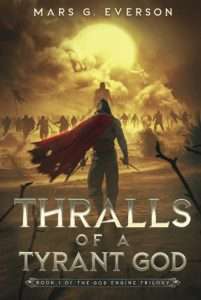 Thralls of a Tyrant God is a book with some unique ideas and interesting characters. Senn, like many of the characters we come across in the novel, is flawed and certainly not a good man. There are many shades of grey throughout the book as the man abandoned by his god begins to question his past and his purpose in such a harsh world. There’s excellent commentary around what it means to be free and the idea of servitude. What is the difference between being on a leash or being a soldier serving a king and country? The dialogue around such ideas is strong and definitely a highlight of the novel and Everson’s writing. The questioning of big ideas drives the plot along as those with power and those without are caught in this difficult world full of corruption and brutality. The oppressive cityscape of the Hub is interesting and gives the novel fantasy dystopian vibes and is another strong point in Thralls of a Tyrant God. Everson has created a world where the reader will yearn for justice and the betterment of its people and that is no small feat.
Thralls of a Tyrant God is a book with some unique ideas and interesting characters. Senn, like many of the characters we come across in the novel, is flawed and certainly not a good man. There are many shades of grey throughout the book as the man abandoned by his god begins to question his past and his purpose in such a harsh world. There’s excellent commentary around what it means to be free and the idea of servitude. What is the difference between being on a leash or being a soldier serving a king and country? The dialogue around such ideas is strong and definitely a highlight of the novel and Everson’s writing. The questioning of big ideas drives the plot along as those with power and those without are caught in this difficult world full of corruption and brutality. The oppressive cityscape of the Hub is interesting and gives the novel fantasy dystopian vibes and is another strong point in Thralls of a Tyrant God. Everson has created a world where the reader will yearn for justice and the betterment of its people and that is no small feat.
Thralls of a Tyrant God ticks along at a quick pace with familiar story beats mixed with some genuine shocking twists. Both the Hub and the vast, unforgiving Desert are fully fleshed settings that allow Everson to explore deep and rich themes with his characters. A few formatting and editing issues aside, this is a great first novel from Everson full of interesting ideas and morally grey characters you’ll love to root for. There is great potential in the series and in Everson as a writer and I for one can’t wait to see what is next!
A dark and interesting world full of complex and morally grey characters battling for power and purpose. Thralls of a Tyrant God shows great potential for The God Engine series and Everson. Dark, brutal, but with rays of hope shining through, Thralls of a Tyrant God blends the familiar with the new to start what could be an excellent dark fantasy trilogy.
Read Thralls of a Tyrant God by Mars G. EversonThe post REVIEW: Thralls of a Tyrant God by Mars G. Everson appeared first on Grimdark Magazine.
August 11, 2023
REVIEW: Conan the Barbarian #1 by Jim Zub (W) and Roberto De La Torre (A)
This first installment of Titan Comics’ Conan the Barbarian is set eight years after the debut Free Comic Book Day issue. Still just 24 years old, Conan is already a veteran of numerous battles and brushes with supernatural horrors. Since putting his homeland of Cimmeria behind him, he’s ranged from Asgard to Nemedia, Corinthia to Zamora. As a teenager he left the burned-out outpost of Venarium curious about the outside world, only to discover dishonorable men at every turn. Tired and embittered, he has come full circle, to the northern Aquilonian frontier town of Hauler’s Roam, not far from both Venarium and Cimmeria. After a violent altercation with the incompetent and cowardly leader of his most recent employer, a mercenary band, Conan pauses to consider his next move. His respite is short-lived, however, as an enigmatic Pictish horsewoman gallops into town warning of the Army of the Lost: a horde of undead raiders. As the sky is plunged into an eerie darkness, Conan must once more take up his sword against a preternatural threat.
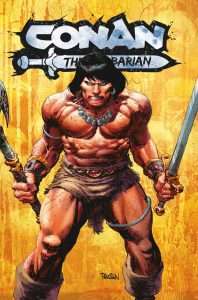 In this first full-length issue, Robert De La Torre’s artwork continues to display a strong (and pleasing!) John Buscema influence without slavishly aping the fan-favorite Marvel artist. The artwork is dynamic and gory, with a surprising number of decapitations for a single issue. There’s also a single panel with bare breasts on display, perhaps signaling that this series will hew closer to the more adult-oriented Savage Sword of Conan magazine of the 1970s than the all-ages Marvel Conan the Barbarian comic that ran in parallel. My only complaint with the artwork thus far is that sometimes the “camera” feels a little too distant from the action, making faces indistinct.
In this first full-length issue, Robert De La Torre’s artwork continues to display a strong (and pleasing!) John Buscema influence without slavishly aping the fan-favorite Marvel artist. The artwork is dynamic and gory, with a surprising number of decapitations for a single issue. There’s also a single panel with bare breasts on display, perhaps signaling that this series will hew closer to the more adult-oriented Savage Sword of Conan magazine of the 1970s than the all-ages Marvel Conan the Barbarian comic that ran in parallel. My only complaint with the artwork thus far is that sometimes the “camera” feels a little too distant from the action, making faces indistinct.
Jim Zub’s writing is punchy but restrained. Quite frequently comic authors seeking to emulate Conan creator Robert E. Howard’s “blood and thunder” prose end up cramming too much text into the panels, paradoxically slowing the reader down with wordy, breathless narration. Zub wisely lets the artwork do the heavy lifting, highlighting and emphasizing the action with his text rather than unnecessarily repeating it.
As with the Free Comic Book Day issue, Conan the Barbarian #1 closes with another brief article by Conan scholar Jeffrey Shanks, this time entitled “Robert E. Howard and His Ages Undreamed Of.” As the Pictish people feature heavily in this issue, Shanks discusses how Picts, Atlanteans, Lemurians, and other antediluvian races reappear across Howard’s non-Conan work, resulting in a sort of greater shared universe. Shanks’ essays provide useful context for the original stories that inspired the comic and are kept brief enough that they’re unlikely to intimidate newcomers. Intriguingly, both this and the previous essay seem to hint that Titan Comics and Howard Estate rights-holders Heroic Signatures are planning to gradually expand their collaboration to non-Conan characters. Perhaps King Kull of Atlantis and the vengeful Puritan Solomon Kane are due for a comeback.
Titan’s Conan the Barbarian #1 starts off with a bang, very clearly setting expectations for the series to come. We’re introduced to Conan, given a quick demonstration of the rough honor code this barbarian lives by, and then see him pitted against a rapidly escalating otherworldly menace. The stage has been set for a compelling original Conan adventure and I look forward to seeing the creative team ramp up the excitement in subsequent issues.
Read Conan the Barbarian #1 by Jim Zub (W) and Roberto De La Torre (A)The post REVIEW: Conan the Barbarian #1 by Jim Zub (W) and Roberto De La Torre (A) appeared first on Grimdark Magazine.
August 10, 2023
REVIEW: Secret Invasion- Episode 6 ‘Home’
Secret Invasion- Episode 6 ‘Home’ ends with an attempt at a bang instead of a whimper but sadly ends up falling flat on its face. I had high hopes for Secret Invasion when it first happened but the start of the show disappointed me by wasting Colbie Smulder’s Maria Hill and the show never quite recovered, especially since it had so many questionable decisions by our protagonists as well as plot holes. I really wanted to like this show but, unfortunately, I’m going to have to give it a D+ and that’s only because Samuel L. Jackson, Emilia Clarke, Olivia Coleman, and Ben Mendelson are doing their best to elevate the material.
Basically, like I predicted in my last review, the big climax of the show is a big CGI punch out between Gi’ah and Gravik. This is easily the laziest way you can resolve the conflict between two competing ideologies. Except, as far as I’m concerned, there’s no idealogies on display. Gi’ah seemed okay with Gravik’s insane plan until she found out that he murdered her mother (then murdered her father). Fury never even gets to speak with Gravik before he’s killed, though they to have it both ways by having Gi’ah impersonate Fury. That doesn’t work, though, since anything she says can’t be taken as gospel of what Fury would have said.
The show never explains why Fury never found a homeworld for the Skrulls and the explanation that Gi’ah Fury gives is that Nick hoped that they would eventually adopt Earth. Which is ridiculous as Nick clearly didn’t think Skrulls would ever be accepted on Terra Firma. More likely, Gi’ah is repeating her father’s opinions. If they’d bothered to state this, then I might have actually been interested in the emotional developments of the final fight.
The rest of the episode has Nick Fury attempting to prevent President Bixton from starting World War 3 by bombing Russia to get rid of the Skrulls. There are so many plot holes in this that it is difficult to deal with. Not the least being that Fury could have assembled at least some Avengers or soldiers to take down the Skrulls guarding the President or just shot Rhodey. Rhodey would have turned into a Skrull and the problem would have been solved.
But the ending’s coda is the nastiest part of all of this as all the efforts to show Skrulls are not all genocidal monsters by Talos, including saving the President’s life, amount to nothing. He makes a big hate filled speech and starts mass murder of Skrulls (as well as innocents mistaken for Skrulls). I think this is supposed to be related to January 6th but whatever message the show is trying to tell is completely muddled. “Yeah, he’s racist against Skrulls but a bunch of Skrulls really are genocidal madmen.”
There are so many questions raised by the finale that I don’t know where to begin. So, Gi’ah just has all the powers of the Avengers now and is the Super-Duper Skrull? She can just beat up Carol Danvers and Thor with one hand? Fury’s plan amounted to giving Gravik this exact same power and hope that Gi’ah won? When did Rhodey disappear? Was it before Endgame? Why in the world would Gi’ah agree to work with Sonya Falsworth? What was the whole point of this? Did the producers how many Anti-Semitic/Anti-Refugee conspiracy theories this played into or was that the point?
Most of all, though, the show just feels lazy and boring. It wastes two well-liked characters and never shows Nick Fury as the cunning mastermind he is. Here’s just a few suggestions they could have made to make the story better:
* Gravik is a leader of a rogue faction.
* Don’t kill Talos and Maria Hill.
* Gravik has a motive better than Fury not finding them a home planet.
* Fury poisons the Harvest and Gravik kills himself fighting a much weaker G’iah.
* Fury is there.
* Hill and Talos stop the President being forced to bomb Russia.
* Don’t use Russia, use Latveria or Symkaria. We’d buy it.
* Keep Fury’s monologues because they’re the best part of the show.
* Make this a movie and 2 hours long so you don’t have to focus on all the boring parts.
Except, here’s the thing, it still wouldn’t be that good. It would be a perfectly passable movie and maybe a C+ or B- if it’s done exceptionally well. It wouldn’t be a boring slog, though, that trades in offensive conspiracy theory as well as badly done plotting. This supposedly cost $200,000,000 and I have no idea where the money is supposed to have been spent. Hawkeye and Ms. Marvel weren’t fantastic, but they were miles better than this. Loki and Wandavision were shows I outright didn’t like it but at least I respected them as an attempt to do something artistic. This is The Phantom Menace level bad.
The post REVIEW: Secret Invasion- Episode 6 ‘Home’ appeared first on Grimdark Magazine.
REVIEW: The Last Voyage of the Demeter
The Last Voyage of the Demeter (also known as Dracula: Voyage of the Demeter) is another film directly inspired by Bram Stoker’s Dracula. This time, the story is based on the section of the novel known as the ‘Captain’s Log’. For those unfamiliar, Dracula travels from Varna, Bulgaria to England on board a ship called the Demeter. The ship ultimately arrives in England derelict and crewless. This isn’t really a spoiler as the opening film goes out of its way (needlessly, in my view) to set this up from the outset. The Captain’s Log, as you might have guessed, is a set of notes taken by the Captain of the Demeter as things go sideways on the voyage. It’s epistolary in nature (as is the rest of Dracula), meaning there’s quite a bit of room for imagination by the writers/director. Do they take full advantage of this? I’m not so sure.
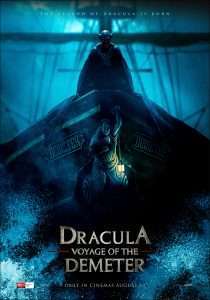 The Last Voyage of the Demeter spent a while in development hell, with numerous directors and actors attached to it over time. The version we got is directed by André Øvredal (The Autopsy of Jane Doe and Troll Hunter) and based on a screenplay by Bragi Schut (Escape Room and Season of the Witch), and Zak Olkewicz (Bullet Train). In an interview, Øvredal described it as “basically Alien on a ship in 1897″. Unfortunately, The Last Voyage of the Demeter does not hit the heights of Alien (few films do), but the concept itself is a good one.
The Last Voyage of the Demeter spent a while in development hell, with numerous directors and actors attached to it over time. The version we got is directed by André Øvredal (The Autopsy of Jane Doe and Troll Hunter) and based on a screenplay by Bragi Schut (Escape Room and Season of the Witch), and Zak Olkewicz (Bullet Train). In an interview, Øvredal described it as “basically Alien on a ship in 1897″. Unfortunately, The Last Voyage of the Demeter does not hit the heights of Alien (few films do), but the concept itself is a good one.
The Last Voyage of the Demeter adds some additional characters to those mentioned in the novel. First and foremost is Clemens, played by Corey Hawkins (The Tragedy of Macbeth), a learned man hitching a ride back to England, and then Anna, played by Aisling Franciosi (The Nightingale), a mysterious stowaway. Hawkins and Franciosi, together with Liam Cunningham (Game of Thrones), are the standouts, breathing life into some mediocre dialogue. David Dastmalchian, who plays the first mate, is also a solid contributor. There are a few additional characters, but they don’t add a lot beyond being fodder for Dracula.
Visually, there is quite a bit to like about The Last Voyage of the Demeter. There were several visually pleasing shots, but it was the production design in particular that impressed me. From Varna (seemingly shot in Malta), to the Demeter, to England, we see a commitment to costumes and set design. It’s obvious that a lot of care went into constructing the sets for the Demeter, where the bulk of the film takes place. A similar care is taken with respect to practical effects. A lot of people get bitten in this movie (shocking, I know), so it was good to see the bites were practically rendered and there was quite a bit of gore (could’ve used more). The monster design for Dracula was good (even if I prefer the suave aristocrat vibe in general).
Leaning into the horror angle was a good idea, but I don’t think they nailed it. Too much time was spent on uninteresting character dynamics and not enough on building tension. Instead of tension, we got a series of jump scares (some of which worked for me). I am not the biggest fan of jump scares in general though, so take my dislike with a grain of salt. In my ideal world, I’d have loved to see a shorter, stripped back version of The Last Voyage of the Demeter, like a typical slasher film (but with Dracula!). Criticisms aside, there are some fun kills. The film did a good job at conveying just how far out of everyone’s league Dracula was, and it was quite enjoyable watching him toy with his victims before killing them.
The Last Voyage of the Demeter certainly isn’t the first horror film where characters make terrible decisions, but some of the decision-making on display strained belief. And that’s probably my biggest complaint, the writing. The plot is full of contrivances and there’s quite a bit of mediocre dialogue. And it’s too bad, because the rest of the film is solid. If you can set the nitpicking side of your brain aside, it’s worth checking out. Who doesn’t want to watch a doomed crew of sailors slowly getting taken apart by a monstrous Dracula?
The post REVIEW: The Last Voyage of the Demeter appeared first on Grimdark Magazine.
August 9, 2023
REVIEW: Lord and King by P.L. Stuart
P.L. Stuart soars to magnificent new heights with Lord and King, the third volume of his Drowned Kingdom Saga inspired by the legend of Atlantis. The first book of the series, A Drowned Kingdom, introduces us to Prince Othrun and the events leading up to the dramatic submersion of his island kingdom. The second book, The Last of the Atalanteans, follows Othrun as he builds a new kingdom in a foreign land, together with the remaining 1,800 Atalantean survivors who escaped the Drowned Kingdom.
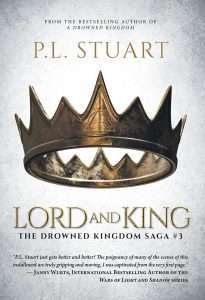 Lord and King finds Othrun as the newly crowned King of Eastrealm, trying to strike a balance between strict Atalantean values and the divergent views of the local populace. For Othrun the mission is divine, sent by his angelic father to spread the religion of his Single God throughout a land of pagans.
Lord and King finds Othrun as the newly crowned King of Eastrealm, trying to strike a balance between strict Atalantean values and the divergent views of the local populace. For Othrun the mission is divine, sent by his angelic father to spread the religion of his Single God throughout a land of pagans.
As king, Othrun seems well poised to live up to the Atalantean reputation as ruthless conquerors and colonizers. Othrun is obsessed with crafting his legacy, both through present-day political manipulation and by rewriting history to conform to his bigoted views. Othrun is intent on erasing inconvenient truths from his people’s history.
I remain in awe of P.L. Stuart as a writer, especially the way he captures immense emotional and psychological depth with prose that is eminently readable. Stuart also manages to keep up an exhilarating pace throughout Lord and King from the opening prologue through the final page. With each book in the series, Stuart further refines his craft.
My favorite character in Lord and King is Aliaz, Othrun’s wife who is now expecting their first child and heir to the throne. Aliaz is the perfect foil to Othrun: kind, honest, tolerant, and considerate of those coming from different backgrounds. She is also a pragmatist, understanding when compromises need to be made for the benefit of the kingdom.
Despite his significant flaws, Othrun is surprisingly self-reflective. Othrun’s introspective nature is evident early in the novel when he asks Aliaz, “Am I a good king?” and then, “Am I a good man?” Othrun seems genuine in asking these questions, and Aliaz offers her honest answers.
Lord and King is brimming with scenes that provide new perspectives on events from the first two books of the series. Stuart’s use of foreshadowing is brilliant, truly astounding me at around the halfway point of the novel.
I’ve described the Drowned Kingdom Saga as a dark fantasy series in each of my reviews. But could it also be described as grimdark? Here at Grimdark Magazine we use the working definition of grimdark as “a grim story told in a dark world by a morally ambiguous protagonist or anti-hero.” In that sense, the Drowned Kingdom Saga truly is grimdark. Although P.L. Stuart eschews the ultraviolence found in many grimdark novels, there is still plenty of excellent action in this series. But with its primary focus on the evolution of Othrun’s mental state, I’d argue that the Drowned Kingdom Saga can most appropriately be classified as psychological grimdark. It’s the type of story that Fyodor Dostoevsky would write if he were into fantasy.
Othrun also experiences an unexpected amount of character growth in Lord and King, suggesting that the Drowned Kingdom Saga might ultimately be a tale of redemption comparable to Mark Lawrence’s Broken Empire trilogy. At this point, I could see Othrun going either way.
P.L. Stuart truly knocked this one out of the park, as Lord and King is outstanding in every respect. The Drowned Kingdom Saga is highly recommended for grimdark fans and anyone who enjoys a deeply thought-provoking, character-driven fantasy. The story will continue with A Lion’s Pride, the fourth book which also marks the midpoint of the planned seven-book series.
5/5
Read Lord and King by P.L. StuartThe post REVIEW: Lord and King by P.L. Stuart appeared first on Grimdark Magazine.
August 8, 2023
REVIEW: Secret Invasion- Episode 5 ‘Harvest’
Secret Invasion- Episode 5 ‘Harvest’ is probably the best episode of the series because it may not do much to fix the series’ many flaws, but it does at least have a bunch of things happening. These things may not be the best decisions they could have made with the show and yet another important character is confirmed dead for seemingly no real reason (the stakes are already sky high) but the episode is at least entertaining.
The premise is Gravik’s failure to assassinate President Ritson has resulted in the Skrulls under his command starting to lose faith in his leadership. Unfortunately, they severely overestimate how much that Gravik is willing to listen to their complaints and executes one of his men as an example to the others. This soon results in more rebellion from the men and an attempted assassination attempt that Gravik’s superpowers swiftly crushes. It does highlight that he’s lost all confidence of his people.
Nick Fury finds himself trying to protect the President against Rhodey (who is secretly a Skrull). Nick Fury doesn’t think to just tell the President, “Rhodey is a Skrull.” He does tell him not to trust Rhodey but it seems like this is something that would be far more useful in the long run. However, not only is Rhodey a Skrull but also the Secret Service so it seems silly they can’t just finish off the President now.
In fact, part of the problem is that we only now find out why Gravik hasn’t killed Nick Fury. Previous episodes suggested that Gravik just didn’t think Nick was a threat but now we’re having “The Harvest” introduced that is apparently a bunch of DNA of all the various superheroes in the Marvel Cinematic Universe. Presumably, so Gravik could gain all of the various superpowers that his machine is able to graft onto Skrull biology. This is fine but Gravik had plenty of opportunities to go after Fury, kidnap him, and force him to give that up so it just seems inconsistent.
Really, the show seems torn between the fact that it wants to be a common superhero show with good versus evil, big theatrical bad guys, and saving the world versus a spy show that usually depends on using your wits versus cosmic powers. Captain America: The Winter Soldier managed to thread this needle by using Hydra vs. Shield but still had the latter morally compromised by their involvement in the military industrial complex.
The waste of Talos as a character is something that does get a decent coda in Gi’ah and Varra giving him a proper funeral. Still, I can’t help but think it’s another character being killed off for the sake of cheap drama. Talos was much more interesting when he was the sole voice of peace and believing in peaceful coexistence with humanity. A Skrull Charles Xavier if you will.
With only one episode left to wrap up the series, I’m afraid that the only way Secret Invasion is going to be able to wrap itself up is a pointless punch-out between superpowered CGI monsters. Which is something that She-Hulk: Attorney at Law already made fun of.
The post REVIEW: Secret Invasion- Episode 5 ‘Harvest’ appeared first on Grimdark Magazine.



